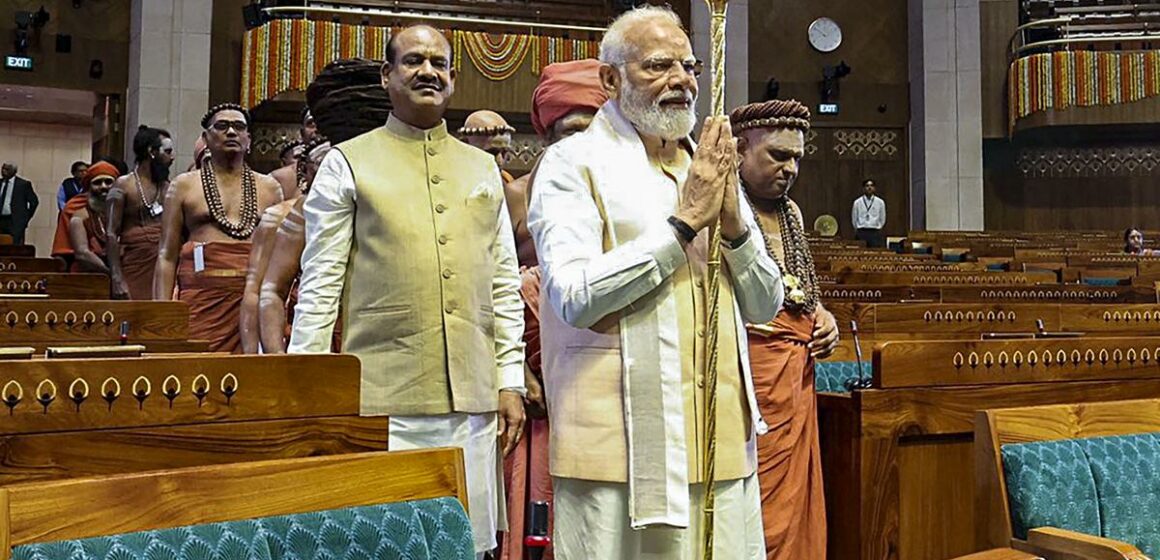The installation of the Sengol, known as the “sceptre of righteousness,” in India’s new Parliament building has sparked a debate on its cultural significance and its compatibility with modern democratic principles. Prime Minister Narendra Modi ceremonially placed this ancient South Indian symbol of dharmic kingship near the Speaker’s chair last May, reigniting discussions on its role in contemporary governance.
Understanding the Sengol: Symbol of Dharmic Kingship
The Sengol holds deep cultural and historical significance in South India, where it traditionally symbolizes the authority and righteousness of kingship. Historically, it represents the ruler’s duty to uphold justice and moral order in society, embodying principles rooted in dharma (righteousness) and governance based on ethical conduct.
Historical Context and Installation in Parliament
In 2023, Prime Minister Modi’s symbolic installation of the Sengol aimed to connect modern governance with India’s rich cultural heritage. The move was seen as a gesture to integrate traditional symbols into the nation’s democratic framework, reflecting a broader narrative of cultural continuity and identity amidst modernization.
Contemporary Controversy: Clash with Constitutional Values
The recent controversy surrounding the Sengol centers on its perceived clash with constitutional values and principles of democratic governance. Samajwadi Party MP R K Chaudhary’s critique highlights concerns that the Sengol, interpreted as the “king’s stick” or “raj-dand,” could symbolically undermine the authority of the Constitution in independent India.
Chaudhary argues that as a nation committed to democratic ideals and constitutional governance, symbols like the Sengol, which historically signify monarchical authority, may not align with the principles of equality, rule of law, and secularism enshrined in the Constitution. His demand to remove the Sengol from Parliament reflects broader anxieties about the preservation of India’s constitutional ethos in the face of symbolic gestures rooted in pre-democratic traditions.
Cultural Heritage vs. Constitutional Principles
Proponents of retaining the Sengol in Parliament emphasize its cultural and historical importance as a civilizational symbol that connects modern India with its ancient roots. They argue that acknowledging and integrating traditional symbols into contemporary governance can foster a sense of continuity, pride, and national identity.
However, critics caution against romanticizing historical symbols without considering their implications for inclusive and secular governance. They contend that while cultural heritage is vital, it should not overshadow the primacy of constitutional values that safeguard pluralism, individual rights, and democratic norms.
Government Response and Public Discourse
The government’s response to the controversy remains pivotal. It must balance honoring cultural heritage with upholding constitutional principles. Prime Minister Modi’s symbolic gesture aimed to celebrate India’s diverse cultural tapestry, but it has also triggered a necessary dialogue on the role of symbolism in shaping national identity and governance in contemporary India.
The installation of the Sengol, known as the “sceptre of righteousness,” in India’s new Parliament building has sparked a debate on its cultural significance and its compatibility with modern democratic principles. Prime Minister Narendra Modi ceremonially placed this ancient South Indian symbol of dharmic kingship near the Speaker’s chair last May, reigniting discussions on its role in contemporary governance.
Understanding the Sengol: Symbol of Dharmic Kingship
The Sengol holds deep cultural and historical significance in South India, where it traditionally symbolizes the authority and righteousness of kingship. Historically, it represents the ruler’s duty to uphold justice and moral order in society, embodying principles rooted in dharma (righteousness) and governance based on ethical conduct.
Historical Context and Installation in Parliament
In 2023, Prime Minister Modi’s symbolic installation of the Sengol aimed to connect modern governance with India’s rich cultural heritage. The move was seen as a gesture to integrate traditional symbols into the nation’s democratic framework, reflecting a broader narrative of cultural continuity and identity amidst modernization.
Contemporary Controversy: Clash with Constitutional Values
The recent controversy surrounding the Sengol centers on its perceived clash with constitutional values and principles of democratic governance. Samajwadi Party MP R K Chaudhary’s critique highlights concerns that the Sengol, interpreted as the “king’s stick” or “raj-dand,” could symbolically undermine the authority of the Constitution in independent India.
Chaudhary argues that as a nation committed to democratic ideals and constitutional governance, symbols like the Sengol, which historically signify monarchical authority, may not align with the principles of equality, rule of law, and secularism enshrined in the Constitution. His demand to remove the Sengol from Parliament reflects broader anxieties about the preservation of India’s constitutional ethos in the face of symbolic gestures rooted in pre-democratic traditions.
Cultural Heritage vs. Constitutional Principles
Proponents of retaining the Sengol in Parliament emphasize its cultural and historical importance as a civilizational symbol that connects modern India with its ancient roots. They argue that acknowledging and integrating traditional symbols into contemporary governance can foster a sense of continuity, pride, and national identity.
critics caution against romanticizing historical symbols without considering their implications for inclusive and secular governance. They contend that while cultural heritage is vital, it should not overshadow the primacy of constitutional values that safeguard pluralism, individual rights, and democratic norms.
Government Response and Public Discourse
The government’s response to the controversy remains pivotal. It must balance honoring cultural heritage with upholding constitutional principles. Prime Minister Modi’s symbolic gesture aimed to celebrate India’s diverse cultural tapestry, but it has also triggered a necessary dialogue on the role of symbolism in shaping national identity and governance in contemporary India.

